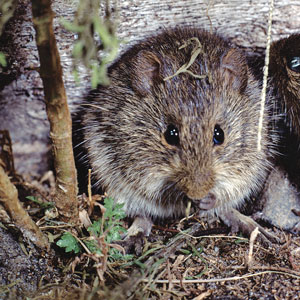
Photo: Weber / iStock / Getty Images Plus / Getty Images
Also known as simply the cotton rat, the hispid cotton rat’s extra adjective means “covered with stiff hair or bristles.” The size of this non-commensal rodent is between a mouse and rat; it’s closer to the meadow vole in biology and behavior. According to the U.S. Forest Service (USFS), it is a member of the family Muridae and subfamily Cricetinae, with approximately 25 accepted subspecies.
Sigmodon hispidus in particular ranges “from the southeastern tip of California, southern Arizona and New Mexico, north to eastern Colorado, eastward through the southern portions of Kansas and Missouri, through Tennessee and North Carolina, and southward along the Atlantic coast through Florida, the Gulf states, and up the Rio Grande Valley,” according to the U.S. Department of Agriculture Cooperative Extension System. The online bulletin also notes “two other species of cotton rat, the least cotton rat (S. minimus) and the yellownose cotton rat (S. ochrognathus), occur only in small areas of southeastern Arizona and southwestern New Mexico. They are very similar to the hispid cotton rat.”
The Internet Center for Wildlife Damage Management (ICWDM) says Sigmodon hispidus boasts a high, “Roman” nose, large eyes, small cheek pouches and rough, stiff, black and grayish fur and guard hairs. At about 4 inches, its “scaly, sparsely haired tail … is shorter than the combined head and body,” so total length averages 10 inches.
Cotton rats are primarily nocturnal but will go out in daylight if food or harborage is scarce. They are active year-round, with a peak breeding season of late spring to early fall. Gestation is about 27 days, and litters can range from one to 15 young. They reach adulthood between 30 days (females) and 60 days (males). Data compiled by the USFS show “hispid cotton rats have been noted as one of the most prolific mammals in the Southeast. Females bear two to several litters per year depending on latitude and local weather. Females mate within 24 hours of giving birth.”
Cotton rats are a public health pest because they can serve as a reservoir for rabies, Chagas’ disease, Hantavirus, West Nile virus and more. Because of its respiratory system, however, the species has historically been used in medical research — including the development of both the polio and typhus vaccines, according to the 2012 book The Laboratory Rabbit, Guinea Pig, Hamster, and Other Rodents.
While wild cotton rat populations are more of an outdoor than indoor pest, they build nests above and below ground and can form runways from food to nest in lawns. According to Orkin’s page on the rat, they can live in barns, brush along fence lines, ditches, gardens, grassy fields, hunting cabins, lake homes and storage sheds.
In such cases, the ICWDM recommends an integrated pest management approach for control. It should focus primarily on habitat modification, such as removing dense cover, and trapping. To protect gardens or other landscape features, the ICWDM suggests burying an 18-inch-tall sheet-metal barrier approximately 6 inches deep to prevent cotton rats from burrowing under or over it.
REFERENCES
- FS.usda.gov/database/feis/animals/mammal/sihi/all.html, accessed Feb. 21, 2024
- ICWDM.org/species/rodents/cotton-rats, accessed Feb. 21, 2024
- NCBI.nlm.nih.gov/pmc/articles/PMC7150299, accessed Feb. 21, 2024
- Orkin.com/pests/rodents/rats/cotton-rats, accessed Feb. 21, 2024
- Wildlife-damage-management.extension.org/cotton-rats, accessed Feb. 21, 2024
Leave A Comment